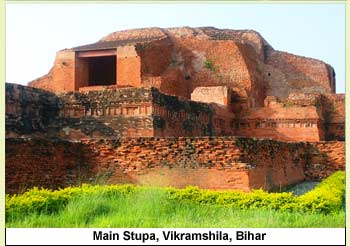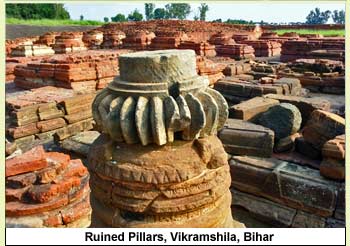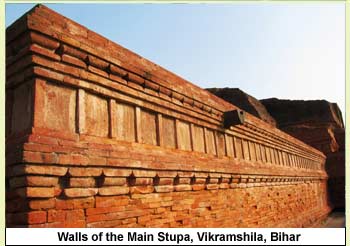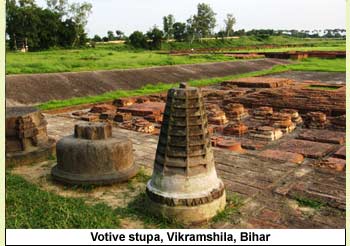|
Almost forgotten even by the local residents of Bhagalpur in Bihar, Vikramshila was one of the three best universities in ancient India, along with Nalanda and Takshashila. SOMEN SENGUPTA visits the now deserted site to tell us more about it
 Neither the filthy railway station nor the overcrowded narrow lanes of Bhagalpur will give you any hint that you are close to a place which in ancient times boosted of a university of international acclaim. Students from across the world would then vie to study here. Today, even after seven years of the end of the inglorious Lalu Prasad era, your car still has to make hard negotiations with the road leading to Kahelgaon, a small industrial town 32 km from Bhagalpur. Then there is a drive of another 10 km to reach the archeological site where once existed Vikramshila Mahavihar, which was one of the three best temples of education in ancient India. While Nalanda, thanks to its proximity to Bodh Gaya, is frequently visited by tourists, and Takshashila being in Pakistan is not easily accessible, Vikramshila lies almost untouched and sadly unexplored. Neither the filthy railway station nor the overcrowded narrow lanes of Bhagalpur will give you any hint that you are close to a place which in ancient times boosted of a university of international acclaim. Students from across the world would then vie to study here. Today, even after seven years of the end of the inglorious Lalu Prasad era, your car still has to make hard negotiations with the road leading to Kahelgaon, a small industrial town 32 km from Bhagalpur. Then there is a drive of another 10 km to reach the archeological site where once existed Vikramshila Mahavihar, which was one of the three best temples of education in ancient India. While Nalanda, thanks to its proximity to Bodh Gaya, is frequently visited by tourists, and Takshashila being in Pakistan is not easily accessible, Vikramshila lies almost untouched and sadly unexplored.
Spread over an area of 100 acres, this ancient university was founded by Dharmapala, the ruler of the Pala dynasty of Bengal in the late eighth century. It existed gloriously for next 400 years as one of the finest educational institutions before it was destroyed by Muslim invaders.
Tibetan scholar Taranath first recorded its existence, calling it Vikramshila Mahavihar. As per Tibetan mythology, a yaksha called Vikramshil was suppressed here, thus giving the place its name. However in India, it was most probably known as Rajagriha Mahavihar, meaning the royal university. This was confirmed by the discovery of several metal certificates from the excavation.
 The university once attracted thousands of students and teachers from various parts of Asia. In its reputation and infrastructure Vikramshila was equal to Nalanda and Odantapuri — two other ancient Buddhist universities in Bihar. While theology, grammar, philosophy, logic, metaphysics, etc, were the areas of study, the most popular subject for which Vikramshila got a worldwide reputation was Vajrayajana Buddhism, which was practised through tantric preceptors. It was the time when necromancy and black magic became the order of the day, influencing both Buddhism and Hinduism. The university once attracted thousands of students and teachers from various parts of Asia. In its reputation and infrastructure Vikramshila was equal to Nalanda and Odantapuri — two other ancient Buddhist universities in Bihar. While theology, grammar, philosophy, logic, metaphysics, etc, were the areas of study, the most popular subject for which Vikramshila got a worldwide reputation was Vajrayajana Buddhism, which was practised through tantric preceptors. It was the time when necromancy and black magic became the order of the day, influencing both Buddhism and Hinduism.
Like any modern university, Vikramshila had a senate or academic council which used to take care of its daily affairs. The exchange of teachers and students between Nalanda and Vikramshila was common in those days. And this was not surprising because King Dharmapala was patron of both the institutions.
After its destruction, the site was abandoned and it remained hidden for centuries. It was discovered by one Lakshmikanta Mishra when he found a mound at Anitichak village. He collected bricks from the debris and sent them to the history department of Patna University. Thereafter, some students of the university started excavating the site, but nothing substantial was found. In 1962, the archeological department of Patna University, along with the Archeological Survey of India, under the leadership of DC Verma, undertook the project to explore the place. Excavation continued till 1969. The ASI again conducted excavation between 1972 and 1982. From these two big projects a huge square monastery with cruciform stupa at its centre, a library, various small stupas and plethora of Hindu and Tibetan temple sculptures were unearthed. It was one of biggest archeological excavations in independent India.
 The main attraction of the site has been a central stupa. Like many other Buddhist sites of worship, here the central stupa is supplemented by several miniature stupas. The central stupa, probably constructed on the remains of Buddha, is made of bricks and solid mud. The two-storied stupa is 15m high. Each level is around 2.5m high and the two terraces are decorated with circumambulatory path that can take you around the structure. The main attraction of the site has been a central stupa. Like many other Buddhist sites of worship, here the central stupa is supplemented by several miniature stupas. The central stupa, probably constructed on the remains of Buddha, is made of bricks and solid mud. The two-storied stupa is 15m high. Each level is around 2.5m high and the two terraces are decorated with circumambulatory path that can take you around the structure.
Walls of both the terraces are embellished with terracotta panels, although many of them are now defaced. The figures that we find are Hindu as well as Buddhist in nature. So one finds Buddha, Jambala, Manjusrei, Tara, etc, on the panels, along with Hindu deities like Vishnu, Parvati and Hanuman. Also, one can see scenes of hunting, snake charming and dancing, along with the figures of yogis, drummers, lions, elephants, etc.
Then there is a residential block meant for monks. This section, which was once a huge structure, now exists in ruins in a shape of a square plot measuring 330m on each side. It has a majestic entrance from north with each flank containing four large chambers. The roof, which is now gone, was once supported by huge pillars. Many of them are still scattered on the ground. The monastery has a total of 208 cells, 52 on each side, for students as well as teachers. A common verandah connects all cells and steps are descending down from the centre to a courtyard. Every cell has three beds. Also, each block has a planned drainage system.
The ruins of the library building give the testimony of Vikramshila’s paramount importance as a centre of Buddhist learning. South of the main monastery, the library is a huge complex. A big reservoir with water, aimed at conditioning the back wall of the building, is also an engineering marvel. This was mainly designed to preserve priceless manuscripts.
Vikramshila touched the zenith of its glory during the 12th century under the rule of Ramapala. It was then regarded as an institution of great repute, almost equal to that of Nalanda. This university had two scholars posted at the main gate. One who wished to become a student could only be allowed if he was found wise enough to defeat these gatekeepers in logic. It provided education for free.
 In the year 1193 when Lakshman Sena, the last Hindu king of Bengal, got vanquished at the hands of Bakhtiyar Khilji, this university was reduced to rubble. Legend has it that Muslim invaders mistakenly took it as a fort and ruthlessly burnt it down. By the end of 1236, Vikramshila was just a deserted debris. Sadly, it was Bakhtiyar Khilji who had also destroyed the Nalanda university. In the year 1193 when Lakshman Sena, the last Hindu king of Bengal, got vanquished at the hands of Bakhtiyar Khilji, this university was reduced to rubble. Legend has it that Muslim invaders mistakenly took it as a fort and ruthlessly burnt it down. By the end of 1236, Vikramshila was just a deserted debris. Sadly, it was Bakhtiyar Khilji who had also destroyed the Nalanda university.
A trip to Vikramshila will remain incomplete without a visit to Archeological Museum set up in November 2004. It displays various priceless piece of work excavated from the site. Apart from several Buddha figurines, there are statues of Loknath, Mahakal, Tara and others. Among Hindu statues, we find Uma, Ganesh, Surya, Kuber and Mahishashumardini. All these statues are curved according to the Pala school of art. Some of them are made of black basalt with an everlasting shine. Other stuff in display are terracotta motifs, coins, household utensils, stone inscriptions, iron arrowheads, ornaments, daggers, etc.
Vikramshila is today forgotten, even by the natives of Bhagalpur. But given its glorious past, it deserves a place in our collective consciousness. A visit to Bhagalpur is all you need to do, and I am sure you won’t forget the place ever in your life.
This article was published on 30th June 2013 in The Pioneer
Click here to view the original article
|



